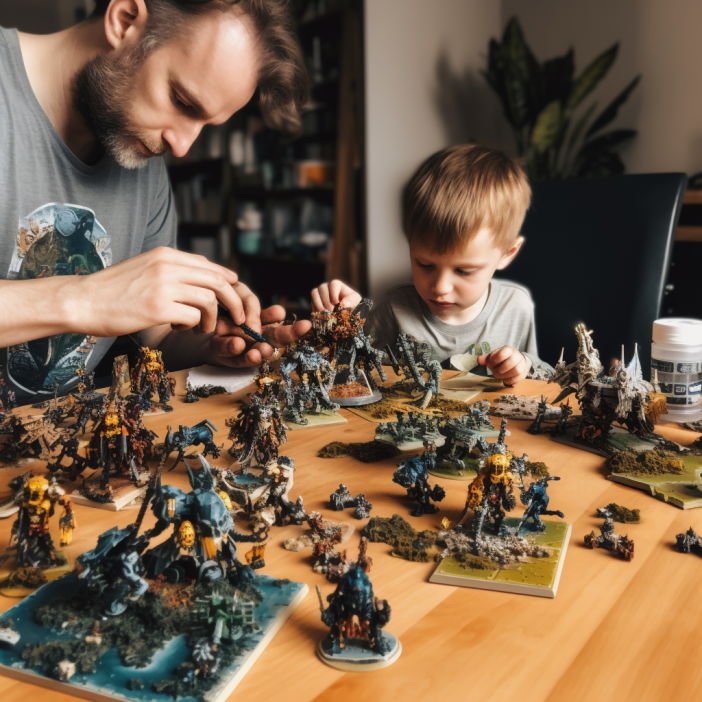Exploring Different Painting Styles for Miniatures
When it comes to painting miniatures, there's a vast array of styles you can experiment with to breathe life into your models. Each painting technique offers its own unique benefits and allows you to create stunning effects that elevate your miniatures to new levels of detail and realism. In this blog post, we will delve into four popular painting styles for miniatures and provide detailed instructions for each style. Whether you're a beginner or an experienced painter, these techniques will open up a world of possibilities for your miniature painting projects.
Basecoat and Wash Technique: Quick and Effective Depth
The basecoat and wash technique is a fundamental approach that provides a solid foundation for your miniature painting. By applying a basecoat and then applying a wash, you can quickly create depth and shadows, adding visual interest to your models. It's an excellent technique for beginners or when you're working on large quantities of miniatures that require a fast yet effective painting method.
Here's how you can achieve this style:
Step 1: Clean and prime your miniature to ensure a smooth painting surface.
Step 2: Apply a basecoat of your chosen color to the entire model. Use thin layers and build up the color gradually for a smoother finish.
Step 3: Once the basecoat is dry, apply a wash. Dilute a darker shade of paint or use a premade wash product and apply it to the recessed areas of the model. The wash will flow into the crevices, creating shadows and adding depth.
Step 4: Allow the wash to dry completely. If necessary, you can use a dry brush to remove excess wash from raised areas for better highlights.
Layering Technique: Smooth Transitions and Gradations
If you're aiming for a smooth and seamless look with gradual transitions between colors, the layering technique is your go-to style. By building up thin layers of paint, you can achieve stunning gradients and blends that add depth and dimension to your miniatures. This technique is ideal for capturing intricate details and achieving a professional-level finish.
Here's how you can achieve this style:
Step 1: Prime your miniature and choose a base color.
Step 2: Apply the basecoat to the entire model, ensuring smooth coverage.
Step 3: Mix your base color with a slightly lighter shade and apply it as a second layer, leaving some areas of the basecoat visible.
Step 4: Repeat the process, gradually adding lighter shades with each layer. Focus on highlighting raised areas and blending the colors smoothly.
Step 5: For the final highlights, mix your base color with a lighter shade and apply it sparingly to the most prominent edges and raised surfaces.
Non-Metallic Metal (NMM) Technique: Shimmering Realism Without Metallic Paints
The non-metallic metal (NMM) technique is a favorite among miniature painters who want to simulate metallic surfaces without using metallic paints. By carefully applying layers of non-metallic colors, you can create convincing illusions of gold, silver, or other metals. This technique allows you to add a touch of realism and brilliance to your miniatures, and it's a valuable skill to have in your painting repertoire.
Here's how you can achieve this style:
Step 1: Prime your miniature and choose the metallic color you want to replicate (e.g., gold, silver, bronze).
Step 2: Apply the basecoat of a matte color that complements the metallic shade. For example, if you're going for gold, use a dark brown or black basecoat.
Step 3: Using thinned paint, start building up the metallic effect by painting thin lines or shapes that mimic the reflections and highlights of metal. Study real metal surfaces or reference images for guidance.
Step 4: Gradually add lighter shades to the reflections, blending them smoothly for a realistic effect.
Step 5: Apply shadows using darker shades, carefully defining the areas where the metal would cast shadows or intersect with other surfaces.
OSL (Object Source Lighting) Technique: Bringing Miniatures to Life with Illumination
If you want to take your miniature painting to the next level and create eye-catching focal points, the Object Source Lighting (OSL) technique is your ticket to success. By simulating the effect of light emitting from a specific object on the miniature, you can bring your models to life and add a sense of drama. Mastering this technique opens up endless possibilities for creating captivating scenes and narratives with your miniatures.
Here's how you can achieve this style:
Step 1: Prime your miniature and choose the color of the light source.
Step 2: Paint the entire model, including the light source, with its base colors.
Step 3: Determine the direction and intensity of the light source. Imagine the light hitting nearby objects and surfaces.
Step 4: Using thin glazes or translucent paints, paint the affected areas with the color of the light source. Apply multiple layers to build up the intensity gradually.
Step 5: Blend the light color with the base colors around the light source, creating a smooth transition.
Step 6: Add additional highlights and reflections on the illuminated areas to enhance the effect.
By exploring these different painting styles, you'll not only expand your painting skills but also add depth, realism, and visual interest to your miniature collection. Remember, practice and experimentation are key to mastering these techniques, so don't be afraid to unleash your creativity and embark on a journey of miniature painting exploration.

